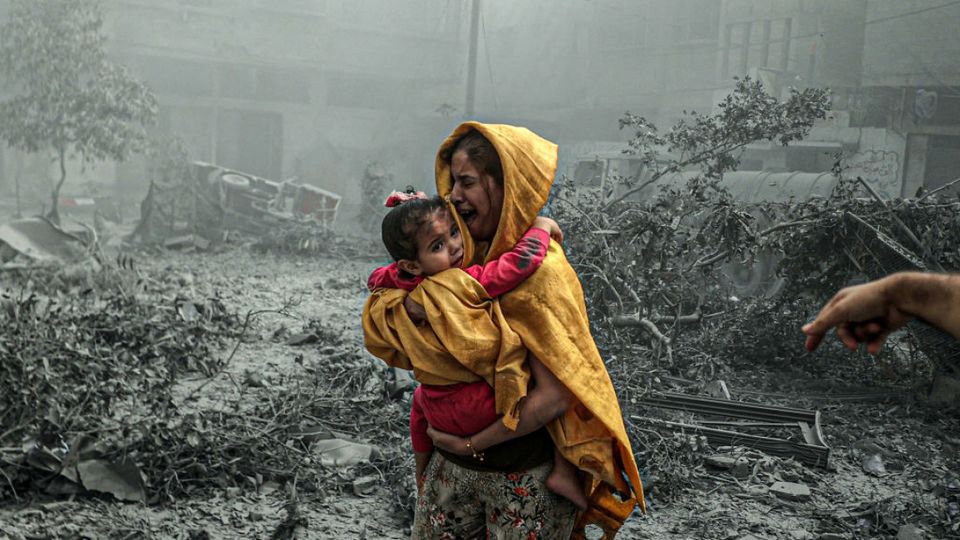Anyone who has voiced opposition to what the government of Israel is currently doing in Gaza has undoubtedly heard the various ways Israel’s defenders excuse, dismiss, and justify Israel’s actions. Sometimes you’ll hear that the Israel Defense Force (IDF) is doing everything in its power—more than any other military in history—to avoid hurting civilians and that Hamas is responsible for any innocents who get killed because they are using them as human shields.
Other times you’ll be told that the people of Gaza, as a whole, deserve what’s happening to them because some of them voted for Hamas eighteen years ago or because Palestinian support for the attacks on October 7 has only grown in the months since.
But there is a common assumption underlying just about every argument you’ll hear. Israel’s defenders act like Prime Minister Benjamin Netanyahu and other top Israeli officials have had no choice but to react to the attacks of October 7 in the manner that they have.
With that assumption smuggled in, defenders can then act like anyone who has problems with what Israel is doing in Gaza is actually opposed to the operation’s stated goals—rescuing the hostages and breaking up Hamas.
It’s a rhetorical trick that is as dishonest as it is ridiculous. Israel did not have to wage an assault on Gaza like this. And, in fact, by doing so, it appears to be impeding its own stated objectives.
Hours after Hamas fighters had withdrawn back to Gaza on October 7 and the IDF had retaken control of the assailed southern border towns, Israel began employing what would become the defining tool of its response: the airstrike.
In the months since, Israeli forces have dropped tens of thousands of bombs on the Gaza Strip. In some cases, these strikes are meant to provide direct air support for IDF troops engaged on the ground. In others, Gazan infrastructure and high-rises in the heart of cities are targeted to help “exert civil pressure” on Hamas.
But most of these strikes are designed to kill men that Israeli forces have determined to be Hamas militants. The method used to select such targets was laid out thoroughly in a recent report by Israeli investigative journalist Yuval Abraham.
Before October 7, the Israeli army designated certain hostile senior military operatives as “human targets.” That meant army rules allowed them to be killed in their private homes even if there were civilians present. But after the Hamas attacks in October, the Israeli military gave all members of Hamas’s military wing that same designation.
According to Abraham’s reporting, the IDF relies on AI tools to handle the high volume of new targets. The first one, Lavender, is designed to identify Hamas operatives using a set of characteristics such as being in a group chat with a known militant, changing addresses often, or switching cell phones every few months. After the threshold was lowered last October, Lavender helped mark approximately thirty-seven thousand Palestinians for assassination.
Another AI tool named The Gospel is then used to identify a target’s private residence. Finally, a third AI program, called Where’s Daddy?, tracks the targets and notifies the IDF when they are at their private residences.
Before a strike is approved, an independent examination by an intelligence analyst takes place. But according to Abraham’s sources, although the IDF estimates that roughly one in ten names identified by Lavender are not actually Hamas operatives, in practice these “examinations” have only really involved checking that the target was male.
After a target is identified as being at home and confirmed to be male, an Israeli plane or drone bombs the residence. Multiple sources told Abraham that IDF rules allowed between fifteen and twenty civilian casualties per strike, and most homes were bombed at night when suspected militants were asleep with their families.
Procedures like this don’t mesh well with the argument that Israel is doing everything in its power to avoid killing civilians. Nor does it bolster the claim that all these civilian deaths are happening because Hamas is using human shields.
The human shield characterization is meant to bring to mind images of Israeli soldiers under fire from militants in a school full of children, forced to either return fire and risk hitting some innocent students or let the militants attack them unimpeded. The IDF killing an entire family because they waited until a suspected militant was at home and everyone was asleep cannot seriously be put in the same category.
To get back to the original point, a widespread bombing campaign with an emphasis on the homes of junior militants is a chosen strategy, not a required one.
On top of that, history has shown that using military force is an ineffective method for breaking up terrorist groups. Most terrorist groups that no longer exist ended because of police action or negotiated settlements with the local government. In other words, Israel would likely fare better in defeating Hamas if it treated them more like criminals than an opposing army.
The same could be said for the effort to free the Israeli hostages held by Hamas. There is probably no worse way to rescue hostages than to drop tens of thousands of bombs on the area where they are being held. Israel could have prioritized rescuing the hostages or securing their release through negotiation and then worked to exact justice on those responsible for taking them. But that’s not the path that was chosen. And now it’s feared that most hostages are already dead.
The fact of the matter is that in choosing to reject the more precise, targeted assassination tactics that Israel has proven adept at in the past or the very hostage rescue operations that drive people to join special forces in favor of this apocalyptic bombing campaign, Netanyahu and his allies have unnecessarily slaughtered Palestinian families, all but abandoned the Israeli hostages, and destroyed almost all the sympathy that Israel garnered after October 7. As long as Israel’s strongest defenders remain in denial, the end of Hamas and the freeing of any hostages who are still alive will continue to be nothing but aspirations.
Reprinted with permission from Mises Institute.


